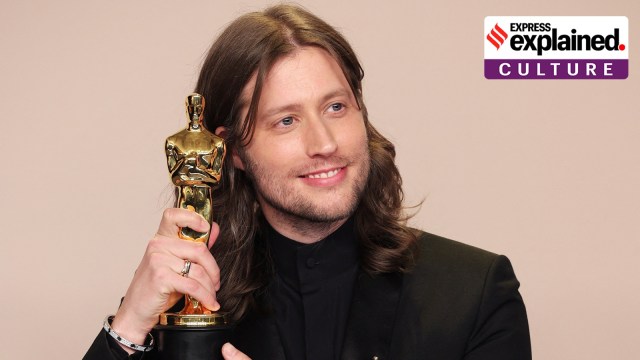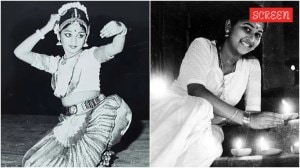What makes Ludwig Göransson, the Oscar winner for ‘Oppenheimer’, a distinctive composer of our time
This was Göransson’s second Oscar after ‘Black Panther’ in 2018. Why does his work stand out, and how has he become the new sonic maverick for music in films?
 Ludwig Göransson poses with the Oscar for Best Original Score for "Oppenheimer" in the Oscars photo room at the 96th Academy Awards in Hollywood, Los Angeles, California, U.S., March 10, 2024. (REUTERS/Carlos Barria)
Ludwig Göransson poses with the Oscar for Best Original Score for "Oppenheimer" in the Oscars photo room at the 96th Academy Awards in Hollywood, Los Angeles, California, U.S., March 10, 2024. (REUTERS/Carlos Barria)Among the seven awards swept up by filmmaker Christopher Nolan’s Oppenheimer at the 96th Academy Awards on Monday (March 11) was 39-year-old Swedish composer Ludwig Göransson’s prize for Best Original Score.
It is a category he has conquered at every major award ceremony this year, including the Golden Globes and the BAFTAS.
Oppenheimer is set in the 1940s and tells the story of the US government’s top-secret Manhattan Project, which aimed to build an atomic bomb before the Nazis did. In the film, Göransson has soundtracked the ideas and ethical dilemmas of theoretical physicist J Robert Oppenheimer – the charismatic scientist who wondered about the profound consequences of giving mankind the means to destroy itself in his endeavour towards scientific advancement.
The introduction of the atomic bomb in Ground Zero through heavy electronic instrumentation, the tension in Trinity through the strings and sporadic bells, the creepy harp in Destroyer of the Worlds, the soft and sometimes wailing violins throughout the film, Göransson musically peels the layers one by one.
Oppenheimer has won Göransson his second Academy Award. He won his first for Marvel’s Black Panther (2018).
Named after Ludwig Beethoven
Hailing from Linköping, a small town in Sweden, Göransson was born to a guitar teacher father and a florist mother. He was named after Ludwig Beethoven, one of the most revered figures in classical music history. The decision to name her son after the German composer was his Polish mother’s choice, overriding his father’s idea, Albert (after blues guitar legend Albert King). He got his first guitar from his father when he was six years old and discovered the heavy metal band Metallica at nine.
His passion for music music spilt over to film soundtracks, especially those by distinguished American composer John Williams – Fiddler on the Roof (1971), Jaws (1975) Star Wars (1977), Superman (1978), Schindler’s List (1993) and Jurassic Park (1998).
At school, a professional orchestra performed a piece that he composed, titled Five Minutes to Christmas. Seeing the performance, he decided this was what he wanted to do.
Professional scoring career
While he first studied jazz at the Royal College of Scotland, Göransson soon moved to the University of Southern California (USC) to study Scoring for Motion Pictures and Television.
Here, he met American filmmaker Ryan Coogler and composed the music for his USC-made short film Fig, released after Göransson worked on his first project, the sitcom Community (2009).
Soon after finishing his course, Göransson assisted composer Theodore Shapiro, known for the film The Devil Wears Prada (2006). He also signed a deal with Jay-Z’s rock label Roc Nation.
While Göransson kept composing, the real success came with Coogler films – Fruitvale Station (2013), Creed (2015), Black Panther (2018) and its follow-up Wakanda Forever (2022). He also worked on the TV series The Mandalorian (2019), part of the Star Wars franchise, and on Christopher Nolan’s Tenet (2020) and Oppenheimer (2023).
Behind Göransson’s sound
In his attempt to find a distinctive sound, Göransson is able to permeate the time-honoured, classic ideas of orchestration and pair them with modern electronic production.
What’s really made his music a class apart is his ability to score for franchise films and filmmakers whose sound concepts and specific tunes are already ingrained in people’s minds. The soundtracks belong to that larger universe, such as Marvel or Star Wars, Pixar or Nolan and still manage to sound unusual.
Rocky’s famed Gonna Fly Now by composer Bill Conti is indelible with its puffed horns, pride and ambition in tow. Hearing Göransson’s score for Creed, the seventh instalment in the Rocky series, it checks all the boxes of the Conti style but has Gorransson’s contemporary kick with R&B and hip-hop rhythms.
The Mandalorian‘s theme is played on a bass recorder, which sounds like a flute, and is then paired with distorted synths, martial percussion and combined strings as the piece gets to the crescendo. The simplicity of the beginning of the tune is again paired with a contemporary punch.
When Coogler asked Göransson to compose for Black Panther, set in Wakanda, a fictional African kingdom, Göransson headed to Senegal for research. He followed it with a week at the International Library of African Music in South Africa, where he found music of the instruments played by various tribes.
He combined African folk music and the sound of traditional instruments with modern orchestra and production to set the tone for the film. The result was a soundtrack firmly perched between traditional African sounds and a modern superhero universe.
Why Oppenheimer’s music stands out
Most of Nolan’s films have long been tied to German composer Hans Zimmer, whose gigantic sounds comprising pianos and cellos have almost leapt at their audiences. The blaring horns, the elegance of the cello and sonic experimentation in films such as The Dark Knight trilogy (co-composed with James Howard Newton), the gentle yet haunting piano and cello work in Inception and Interstellar, the eerieness of the score in the harrowing war epic, Dunkirk, are referred to as the Nolan sound.
But when Zimmer turned down Nolan’s Tenet (2020), so that he could concentrate his energies on Dune, a live-action adaptation of Frank Herbert’s 1965 novel, Nolan chose Göransson, following Black Panther. Göransson surprised him with a rap for the sci-fi thriller, along with retrograde melodies that would sound the same if reversed, considered appropriate for a movie where various objects are travelling back in time.
As for Oppenheimer, Nolan suggested that the composer should try to find the man and the scientist through the violin. The result was Can You Hear the Music? one of the first pieces that Göransson composed.
It is also a question that physicist Niels Bohr asks a young Oppenheimer in the film. “The important thing is not can you read music. It’s can you hear it? Can you hear the music, Robert?” “Yes I can,” says Oppenheimer. Gorransson’s violin follows, like it’s the voice of Oppenheimer, the man who would go on to become the father of the atomic bomb.
Gorranson’s soundtrack for Oppenheimer – romantic and swelling in the beginning, with layered violins that begin gently and are then juxtaposed with horrific sirens, through raucous horns and distorted synths – eventually leads to the film’s pivotal moment of pushing the button for the nuclear test.
Although, the actual moment of the test detonation, which was to change the course of history, is marked in the film by absolute silence. It’s a voiceless, ‘noiseless flash’, followed by a mushroom-like large cloud in the sky.
Amid this silence, Göransson’s earlier build-up – the unusual rhythmic patterns, the rise and fall of strings that signify hope, loneliness and despair, all rolled into one – hits the audience. The beauty of science and what humans can achieve bleeds into the feeling of impending doom and a foreboding, which is felt at its peak in the scene’s silence.



- 01
- 02
- 03
- 04
- 05


































